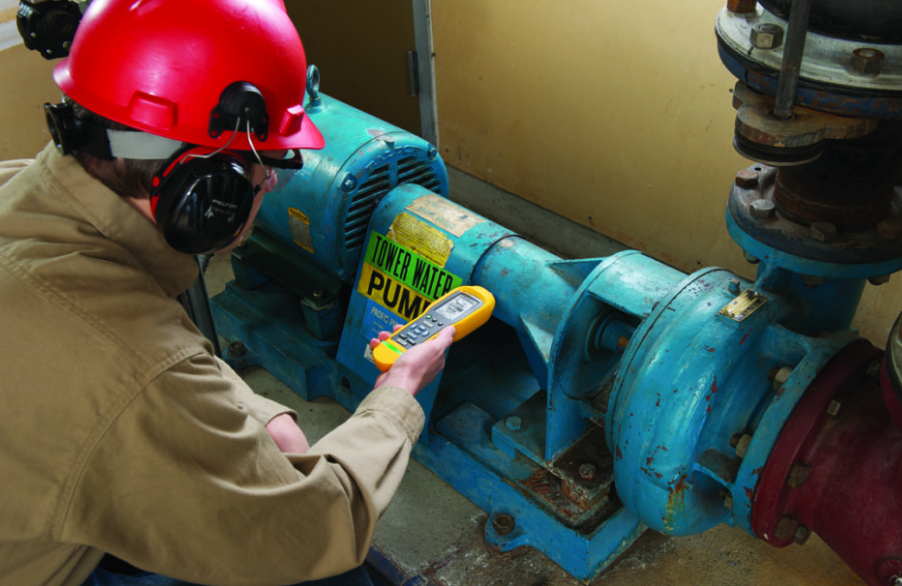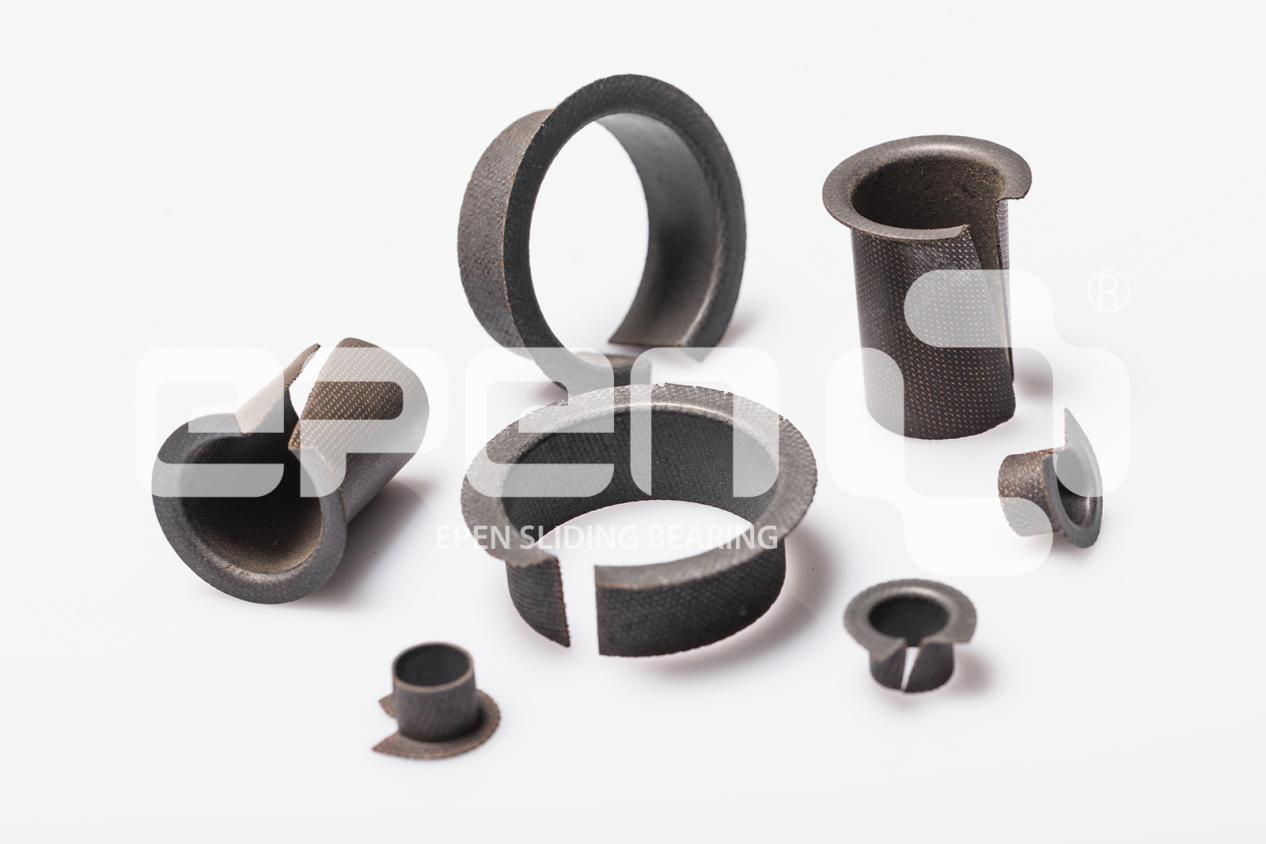Technician performing vibration screening with improved Fluke 805 vibration meter.
Some of the jobs being performed by today’s technicians don’t even have names or descriptions yet and are being added ‘on the fly’ to keep up with today’s innovative tools and advanced equipment condition-monitoring techniques. What was once complex tasks performed only by reliability engineers or specialised contractors, can now be accomplished by less experienced technicians with easy-to-use tools, such as vibration screeners and thermal imagers.
Consequently, this allows analysts and reliability engineers to use their time and expertise more efficiently by examining equipment condition data and making proactive decisions to prevent equipment failure, ultimately saving money.
Case in point—train the technician to use high-tech
Recently, a large, globally-recognised automobile manufacturer successfully deployed maintenance technicians, who normally repair equipment, to also carry out route-based condition monitoring using handheld vibration meters and thermal imagers.
Like many plants, the manufacturer had started to incorporate new technology into their operations, however, much of the machinery was still not equipped with sensors and therefore, little or no equipment condition data was being gathered. Also, no regular condition monitoring routes or schedules had been set up.
Both the company’s thermographer and reliability team supervisor understood the value of equipment condition monitoring concerning proactive maintenance to extend equipment life. They decided to put vibration screening meters and infrared thermal imaging tools and technicians—to the test.
“Our main reason for testing these tools was to see if we could pass along some of the vibration testing and thermography scans to maintenance technicians so the reliability team could concentrate on the most difficult issues,” said the Reliability Supervisor.
“Right now, we’re only able to look at certain pieces of equipment because we only have so much manpower. If maintenance could collect data on more equipment, and the experts could spend their time analysing the data, we could look at everything more frequently. Whatever tools we use have to make it easy for the maintenance techs to upload the data because we want them to be more efficient.”
In the end, the pilot program proved that techs could be deployed to assist the reliability team. It also provided technicians with a nice change of pace from some of their usual tasks.
A natural progression—pairing regular route-based vibration screening with an asset criticality list
With the techs now trained and armed with thermal imaging and vibration screening tools, a natural next step for any manufacturer would be to transition to regular route-based equipment condition monitoring, such as vibration screening.
Obviously, not all equipment is created equal, nor is the failure of a particular machine component, so it makes sense to give more attention to machinery that, should it fail, will have the highest impact on overall production. Many times, the most common culprit for equipment failure is caused by misalignment, looseness, imbalance, bearing wear, and motor electrical issues. By implementing route-based vibration screenings and by prioritising the right schedule based on an asset criticality list, much of the damage that common machine faults can cause can be avoided before they happen.
Prioritise the list
It’s imperative to prioritise assets and rank them in order of importance before making schedules, assigning work orders, and creating routes. Also, ensure the success by selecting a qualified assessment team familiar with the various pieces of equipment; then, together the team can use the quality criteria to gain consensus about why a piece of equipment was included, and how it was ranked.
Rank the assets
Once the assets to be included on the list (by type, size and location, etc.) have been decided on, create a numbering system, such as on a scale of 1 to 5, to rank each asset from ‘most critical’ to ‘least critical’ based on importance to overall production and processes. Lastly, add the numbers up to arrive at a criticality ranking for each piece of equipment.
Develop a screening schedule
Now that the asset criticality analysis list is complete, the next step is to establish a preventive maintenance task for each data collection point on the route for accurately screening machine condition changes. Once the maintenance plan has been established and a fixed route of data collection points is in place, start laying out vibration screening schedules and testing frequencies, such as daily, monthly, bi-monthly, quarterly or yearly, depending on the asset criticality ranking and associated risk factors important to the industry, company and plant. Additionally, identify the appropriate technician or engineer (less-experienced, semi-experienced, highly-experienced) to address the task, depending on the asset ranking, difficulty of the task and expertise/training needed.
Making the switch to a more proactive maintenance approach takes time. Transitioning, or adding to a technician’s skill set early in the process and introducing things like smarter tools will help combat the growing need for a more technologically advanced workforce and will make each consecutive addition to the program that much easier. Additionally, by adding condition monitoring, based on an asset criticality list, companies can improve both personnel and plant efficiency and take quality, proactive actions based on data, to prevent equipment failures before they happen. Remember that reliability is a journey and not a destination. Never stop documenting successes or else a new directive will cancel the great accomplishments that have been seen with the reliability program.
What’s the next step?
One consideration might be the addition of a Cloud-based computer maintenance management system (CMMS), such as eMaint, which allows access to data from Fluke Connect™-enabled handheld tools using a desktop, smartphone or tablet. In conjunction with tools such as thermal imagers and vibration screening tools, a CMMS easily connects workers, like technicians and reliability engineers, to critical historical and real-time data—anytime, anywhere.
Fluke 805FC Vibration Meter now optimised for route-based maintenance
Fluke’s two guiding values are that customers’ opinions, needs and wants are closely listened to and as a consequence, the Fluke meters are continuously improved. The Fluke 805FC Vibration meter now greatly improves the ease of performing vibration screen routes for technicians and managers, enabling better management and monitoring of workflow. Improved features like:
Build equipment setups and maintenance routes using Fluke Connect
Easily push work orders and routes to the technician’s smartphone via Fluke Connect
Add work orders directly to the unit using Fluke Connect mobile App
Easily upload results after measurements are made
Share and view results remotely, receive alerts when equipment heath changes, and view active trends of multiple parameters.
(https://www.cbn.co.za)
More About Us:
Jiashan Epen Bearing Co.Ltd. is a professional manufacturer of plain bearings and wear plates, and has grown rapidly to a point where now all types of plain bearings can be supplied. Standard catalogue sizes, special sizes and designs can be produced at competitive prices and to a high quality standard.
2022 new week Epen product Recommendation:
EUR is two-layer structure, which consists of a bronze mesh Laminated with PTFE Tape. The weight of fininal products is lighter and easy to install due to advantages of this structure. Automotive door hinges is one of typical applications .
http://www.cnepen.cn/showinfo-222-565-0.html
If you’re interested, there are various products here:
https://www.cnepen.cn/listinfo-212-0.html
Contact Us:
Tel: +86-573-8482 4388
Fax: +86-573-8482 4386
Mail us: epen@cnepen.cn
Website: www.cnepen.com



